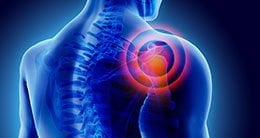Shoulder Care

A shoulder injury can result in pain and loss of function of the shoulder limiting your ability to work, play and even sleep. Often times, these injuries are caused by a traumatic event or excessive use of the shoulder. If you're experiencing pain, weakness and instability in your shoulder, request an appointment with one of our specialists for proper diagnosis and treatment.
We treat a range of shoulder conditions including:
- Arthritis
- Bursitis
- Collarbone/clavical fractures
- Frozen shoulder
- Proximal humerus fracture
- Rotator cuff injury
- Shoulder dislocation
- Shoulder tendinitis
- Shoulder labral tear
Diagnosis and Treatment
Our orthopedic specialists use a variety of techniques to treat shoulder conditions. Our goal is to begin with the most conservative treatment approach. After examination and diagnosis, our specialists will work with you to develop a plan of care to help you achieve the best outcome.
Treatments may include:
- Anti-inflammatory medications
- Cortisone or steroid injections
- Physical therapy
- Reverse total shoulder replacement
- Total surgery replacement
- Rotator cuff repair
- Shoulder joint restoration
- Shoulder resurfacing/partial replacement
- Shoulder surgery rehab
 Shoulder Pain
Shoulder Pain
The shoulder is a ball-and-socket joint that can be structurally unstable and, compared to other joints, more susceptible to dislocation. Repeated dislocations can tear the glenoid labrum--this is the ring of fibrous tissue surrounding the socket in the shoulder. Bankart lesions refer to tears of the inferior or bottom portions of the glenoid labrum; SLAP (Superior Labrum Anterior and Posterior) lesions refer to tears of the labrum's superior or top portions. The glenoid labrum stabilizes the shoulder joint and, without repairing associated tears, young athletes can experience chronic complications into adulthood such as recurring dislocations and arthritis.
After diagnosing tears with an MRI, repairing Bankart or SLAP lesions requires arthroscopic surgery. With arthroscopy, the orthopedic surgeon uses two to three small incisions and a scope (camera) to further inspect and repair tears. While it is a minimally invasive, outpatient procedure, patients generally carry out six weeks of physical therapy and abstain from contact sports for four to six months post-surgery to restore full function and range of motion.